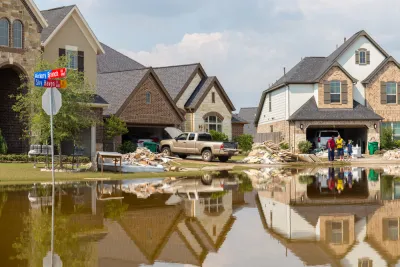Houston's most recent natural disaster is only the latest example of how a program created to help homeowners has been a greater benefit to the industries that profit from them.

An exhaustive piece by the Houston Chronicle that is both study of, and investigation into, the National Flood Insurance Program, begins with the statement that it is a failure.
“The impact of Congress' failure is undisputed. The National Flood Insurance Program was supposed to discourage development in flood-prone areas, but new development has spread across flood plains, including thousands of homes in the Houston area that flooded during Hurricane Harvey.”
It’s hard to disagree, when an earlier installment of the Chronicle’s enterprise series noted that a development for 900 new houses in an area that flooded during Harvey nearly slipped through the City Council unopposed only two months after the hurricane.
The National Flood Insurance Program has existed since 1968, but even as it was being designed lawmakers recognized the risk.
“In 1966, a task force commissioned by President Lyndon B. Johnson recommended that the government offer below-market rates to entice property owners to enroll in the program. But it warned that such an approach presented dangers if low insurance costs were allowed to become incentives for building in flood-prone area.”
Those below-market premiums have meant that the program cannot pay for itself. It has required taxpayer bailouts 16 times in 25 years, according to the Chronicle, and is $20 billion in debt—and that’s before it pays out another $10 billion in claims from Hurricane Harvey.
Legislation that would raise insurance premiums has generally been thwarted, often by lawmakers whose constituents benefit from booming real estate markets, or often who have received significant donations from industries related to building and real estate; last year the National Association of Realtors spent, just on lobbying Congress, four times more money then Exxon-Mobile.
Meanwhile, by financing rebuilding, repeated claims on the same homes under the flood insurance program have at times added up to many times the value of the property.
And ultimately, low premiums on flood insurance are a detriment to homeowners.
“Those subsidies have helped lure generations of homeowners into properties that trap them in a cycle of building, flooding and rebuilding. Henry Thompson and his wife, for example, bought their home not far from Cypress Creek three years ago. They knew the neighborhood northwest of Houston flooded, but the cost of flood insurance was so low — about $400 a year — they bought anyway.
Then Harvey swept 2 feet of water under their threshold, forcing them to live on the second floor for the past three months with a microwave, an electric skillet and two young children. They want to sell, but can't imagine they'll find a buyer, leaving them with little choice but to cash the insurance check, rebuild and wait for the waters to rise again.”
FULL STORY: Build, flood, rebuild: flood insurance’s expensive cycle

Analysis: Cybertruck Fatality Rate Far Exceeds That of Ford Pinto
The Tesla Cybertruck was recalled seven times last year.

National Parks Layoffs Will Cause Communities to Lose Billions
Thousands of essential park workers were laid off this week, just before the busy spring break season.

Retro-silient?: America’s First “Eco-burb,” The Woodlands Turns 50
A master-planned community north of Houston offers lessons on green infrastructure and resilient design, but falls short of its founder’s lofty affordability and walkability goals.

Test News Post 1
This is a summary

Analysis: Cybertruck Fatality Rate Far Exceeds That of Ford Pinto
The Tesla Cybertruck was recalled seven times last year.

Test News Headline 46
Test for the image on the front page.
Urban Design for Planners 1: Software Tools
This six-course series explores essential urban design concepts using open source software and equips planners with the tools they need to participate fully in the urban design process.
Planning for Universal Design
Learn the tools for implementing Universal Design in planning regulations.
EMC Planning Group, Inc.
Planetizen
Planetizen
Mpact (formerly Rail~Volution)
Great Falls Development Authority, Inc.
HUDs Office of Policy Development and Research
NYU Wagner Graduate School of Public Service




























